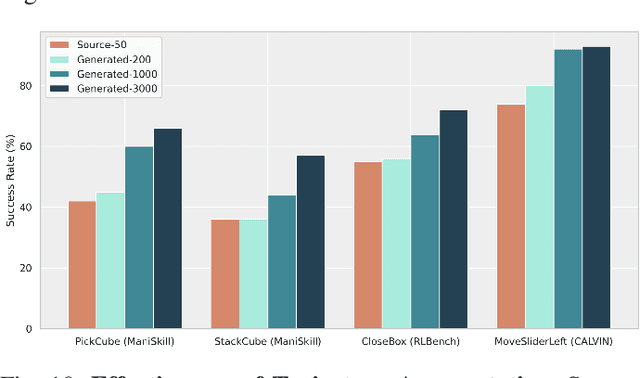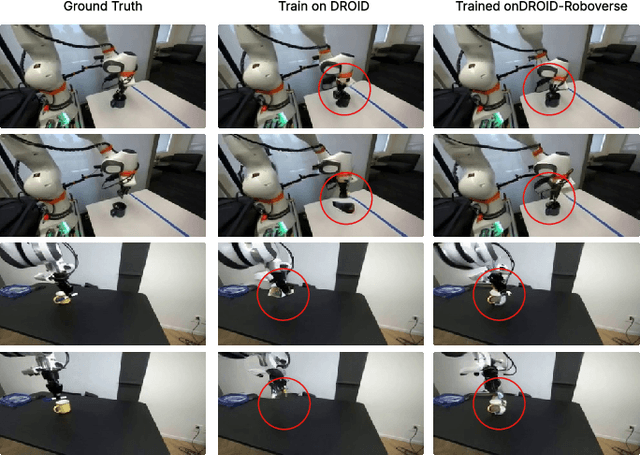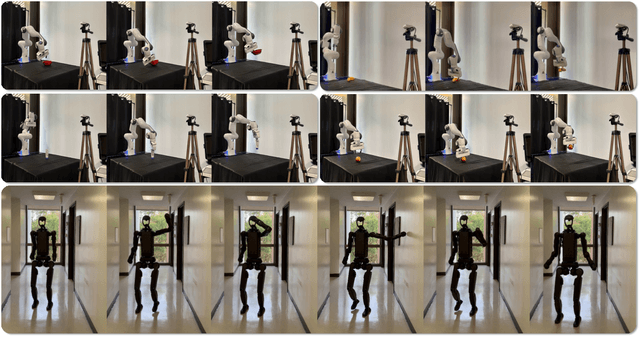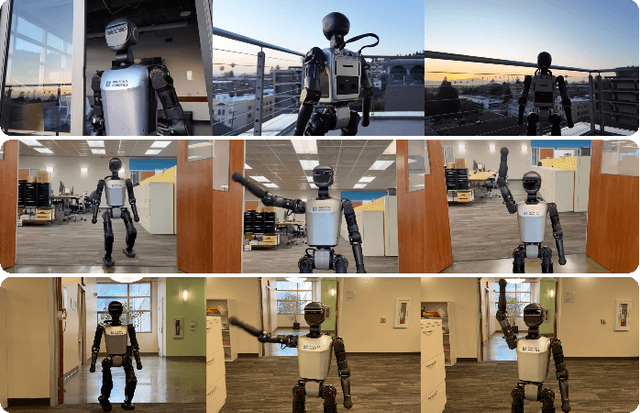Jiazhao Zhang
TrackVLA++: Unleashing Reasoning and Memory Capabilities in VLA Models for Embodied Visual Tracking
Oct 08, 2025Abstract:Embodied Visual Tracking (EVT) is a fundamental ability that underpins practical applications, such as companion robots, guidance robots and service assistants, where continuously following moving targets is essential. Recent advances have enabled language-guided tracking in complex and unstructured scenes. However, existing approaches lack explicit spatial reasoning and effective temporal memory, causing failures under severe occlusions or in the presence of similar-looking distractors. To address these challenges, we present TrackVLA++, a novel Vision-Language-Action (VLA) model that enhances embodied visual tracking with two key modules, a spatial reasoning mechanism and a Target Identification Memory (TIM). The reasoning module introduces a Chain-of-Thought paradigm, termed Polar-CoT, which infers the target's relative position and encodes it as a compact polar-coordinate token for action prediction. Guided by these spatial priors, the TIM employs a gated update strategy to preserve long-horizon target memory, ensuring spatiotemporal consistency and mitigating target loss during extended occlusions. Extensive experiments show that TrackVLA++ achieves state-of-the-art performance on public benchmarks across both egocentric and multi-camera settings. On the challenging EVT-Bench DT split, TrackVLA++ surpasses the previous leading approach by 5.1 and 12, respectively. Furthermore, TrackVLA++ exhibits strong zero-shot generalization, enabling robust real-world tracking in dynamic and occluded scenarios.
RemixFusion: Residual-based Mixed Representation for Large-scale Online RGB-D Reconstruction
Jul 23, 2025Abstract:The introduction of the neural implicit representation has notably propelled the advancement of online dense reconstruction techniques. Compared to traditional explicit representations, such as TSDF, it improves the mapping completeness and memory efficiency. However, the lack of reconstruction details and the time-consuming learning of neural representations hinder the widespread application of neural-based methods to large-scale online reconstruction. We introduce RemixFusion, a novel residual-based mixed representation for scene reconstruction and camera pose estimation dedicated to high-quality and large-scale online RGB-D reconstruction. In particular, we propose a residual-based map representation comprised of an explicit coarse TSDF grid and an implicit neural module that produces residuals representing fine-grained details to be added to the coarse grid. Such mixed representation allows for detail-rich reconstruction with bounded time and memory budget, contrasting with the overly-smoothed results by the purely implicit representations, thus paving the way for high-quality camera tracking. Furthermore, we extend the residual-based representation to handle multi-frame joint pose optimization via bundle adjustment (BA). In contrast to the existing methods, which optimize poses directly, we opt to optimize pose changes. Combined with a novel technique for adaptive gradient amplification, our method attains better optimization convergence and global optimality. Furthermore, we adopt a local moving volume to factorize the mixed scene representation with a divide-and-conquer design to facilitate efficient online learning in our residual-based framework. Extensive experiments demonstrate that our method surpasses all state-of-the-art ones, including those based either on explicit or implicit representations, in terms of the accuracy of both mapping and tracking on large-scale scenes.
BoxFusion: Reconstruction-Free Open-Vocabulary 3D Object Detection via Real-Time Multi-View Box Fusion
Jun 18, 2025Abstract:Open-vocabulary 3D object detection has gained significant interest due to its critical applications in autonomous driving and embodied AI. Existing detection methods, whether offline or online, typically rely on dense point cloud reconstruction, which imposes substantial computational overhead and memory constraints, hindering real-time deployment in downstream tasks. To address this, we propose a novel reconstruction-free online framework tailored for memory-efficient and real-time 3D detection. Specifically, given streaming posed RGB-D video input, we leverage Cubify Anything as a pre-trained visual foundation model (VFM) for single-view 3D object detection by bounding boxes, coupled with CLIP to capture open-vocabulary semantics of detected objects. To fuse all detected bounding boxes across different views into a unified one, we employ an association module for correspondences of multi-views and an optimization module to fuse the 3D bounding boxes of the same instance predicted in multi-views. The association module utilizes 3D Non-Maximum Suppression (NMS) and a box correspondence matching module, while the optimization module uses an IoU-guided efficient random optimization technique based on particle filtering to enforce multi-view consistency of the 3D bounding boxes while minimizing computational complexity. Extensive experiments on ScanNetV2 and CA-1M datasets demonstrate that our method achieves state-of-the-art performance among online methods. Benefiting from this novel reconstruction-free paradigm for 3D object detection, our method exhibits great generalization abilities in various scenarios, enabling real-time perception even in environments exceeding 1000 square meters.
OctoNav: Towards Generalist Embodied Navigation
Jun 11, 2025Abstract:Embodied navigation stands as a foundation pillar within the broader pursuit of embodied AI. However, previous navigation research is divided into different tasks/capabilities, e.g., ObjNav, ImgNav and VLN, where they differ in task objectives and modalities, making datasets and methods are designed individually. In this work, we take steps toward generalist navigation agents, which can follow free-form instructions that include arbitrary compounds of multi-modal and multi-capability. To achieve this, we propose a large-scale benchmark and corresponding method, termed OctoNav-Bench and OctoNav-R1. Specifically, OctoNav-Bench features continuous environments and is constructed via a designed annotation pipeline. We thoroughly craft instruction-trajectory pairs, where instructions are diverse in free-form with arbitrary modality and capability. Also, we construct a Think-Before-Action (TBA-CoT) dataset within OctoNav-Bench to provide the thinking process behind actions. For OctoNav-R1, we build it upon MLLMs and adapt it to a VLA-type model, which can produce low-level actions solely based on 2D visual observations. Moreover, we design a Hybrid Training Paradigm (HTP) that consists of three stages, i.e., Action-/TBA-SFT, Nav-GPRO, and Online RL stages. Each stage contains specifically designed learning policies and rewards. Importantly, for TBA-SFT and Nav-GRPO designs, we are inspired by the OpenAI-o1 and DeepSeek-R1, which show impressive reasoning ability via thinking-before-answer. Thus, we aim to investigate how to achieve thinking-before-action in the embodied navigation field, to improve model's reasoning ability toward generalists. Specifically, we propose TBA-SFT to utilize the TBA-CoT dataset to fine-tune the model as a cold-start phrase and then leverage Nav-GPRO to improve its thinking ability. Finally, OctoNav-R1 shows superior performance compared with previous methods.
TrackVLA: Embodied Visual Tracking in the Wild
May 29, 2025Abstract:Embodied visual tracking is a fundamental skill in Embodied AI, enabling an agent to follow a specific target in dynamic environments using only egocentric vision. This task is inherently challenging as it requires both accurate target recognition and effective trajectory planning under conditions of severe occlusion and high scene dynamics. Existing approaches typically address this challenge through a modular separation of recognition and planning. In this work, we propose TrackVLA, a Vision-Language-Action (VLA) model that learns the synergy between object recognition and trajectory planning. Leveraging a shared LLM backbone, we employ a language modeling head for recognition and an anchor-based diffusion model for trajectory planning. To train TrackVLA, we construct an Embodied Visual Tracking Benchmark (EVT-Bench) and collect diverse difficulty levels of recognition samples, resulting in a dataset of 1.7 million samples. Through extensive experiments in both synthetic and real-world environments, TrackVLA demonstrates SOTA performance and strong generalizability. It significantly outperforms existing methods on public benchmarks in a zero-shot manner while remaining robust to high dynamics and occlusion in real-world scenarios at 10 FPS inference speed. Our project page is: https://pku-epic.github.io/TrackVLA-web.
RoboVerse: Towards a Unified Platform, Dataset and Benchmark for Scalable and Generalizable Robot Learning
Apr 26, 2025



Abstract:Data scaling and standardized evaluation benchmarks have driven significant advances in natural language processing and computer vision. However, robotics faces unique challenges in scaling data and establishing evaluation protocols. Collecting real-world data is resource-intensive and inefficient, while benchmarking in real-world scenarios remains highly complex. Synthetic data and simulation offer promising alternatives, yet existing efforts often fall short in data quality, diversity, and benchmark standardization. To address these challenges, we introduce RoboVerse, a comprehensive framework comprising a simulation platform, a synthetic dataset, and unified benchmarks. Our simulation platform supports multiple simulators and robotic embodiments, enabling seamless transitions between different environments. The synthetic dataset, featuring high-fidelity physics and photorealistic rendering, is constructed through multiple approaches. Additionally, we propose unified benchmarks for imitation learning and reinforcement learning, enabling evaluation across different levels of generalization. At the core of the simulation platform is MetaSim, an infrastructure that abstracts diverse simulation environments into a universal interface. It restructures existing simulation environments into a simulator-agnostic configuration system, as well as an API aligning different simulator functionalities, such as launching simulation environments, loading assets with initial states, stepping the physics engine, etc. This abstraction ensures interoperability and extensibility. Comprehensive experiments demonstrate that RoboVerse enhances the performance of imitation learning, reinforcement learning, world model learning, and sim-to-real transfer. These results validate the reliability of our dataset and benchmarks, establishing RoboVerse as a robust solution for advancing robot learning.
OnlineAnySeg: Online Zero-Shot 3D Segmentation by Visual Foundation Model Guided 2D Mask Merging
Mar 03, 2025Abstract:Online 3D open-vocabulary segmentation of a progressively reconstructed scene is both a critical and challenging task for embodied applications. With the success of visual foundation models (VFMs) in the image domain, leveraging 2D priors to address 3D online segmentation has become a prominent research focus. Since segmentation results provided by 2D priors often require spatial consistency to be lifted into final 3D segmentation, an efficient method for identifying spatial overlap among 2D masks is essential - yet existing methods rarely achieve this in real time, mainly limiting its use to offline approaches. To address this, we propose an efficient method that lifts 2D masks generated by VFMs into a unified 3D instance using a hashing technique. By employing voxel hashing for efficient 3D scene querying, our approach reduces the time complexity of costly spatial overlap queries from $O(n^2)$ to $O(n)$. Accurate spatial associations further enable 3D merging of 2D masks through simple similarity-based filtering in a zero-shot manner, making our approach more robust to incomplete and noisy data. Evaluated on the ScanNet and SceneNN benchmarks, our approach achieves state-of-the-art performance in online, open-vocabulary 3D instance segmentation with leading efficiency.
SoFar: Language-Grounded Orientation Bridges Spatial Reasoning and Object Manipulation
Feb 18, 2025Abstract:Spatial intelligence is a critical component of embodied AI, promoting robots to understand and interact with their environments. While recent advances have enhanced the ability of VLMs to perceive object locations and positional relationships, they still lack the capability to precisely understand object orientations-a key requirement for tasks involving fine-grained manipulations. Addressing this limitation not only requires geometric reasoning but also an expressive and intuitive way to represent orientation. In this context, we propose that natural language offers a more flexible representation space than canonical frames, making it particularly suitable for instruction-following robotic systems. In this paper, we introduce the concept of semantic orientation, which defines object orientations using natural language in a reference-frame-free manner (e.g., the ''plug-in'' direction of a USB or the ''handle'' direction of a knife). To support this, we construct OrienText300K, a large-scale dataset of 3D models annotated with semantic orientations that link geometric understanding to functional semantics. By integrating semantic orientation into a VLM system, we enable robots to generate manipulation actions with both positional and orientational constraints. Extensive experiments in simulation and real world demonstrate that our approach significantly enhances robotic manipulation capabilities, e.g., 48.7% accuracy on Open6DOR and 74.9% accuracy on SIMPLER.
Neural Observation Field Guided Hybrid Optimization of Camera Placement
Dec 11, 2024



Abstract:Camera placement is crutial in multi-camera systems such as virtual reality, autonomous driving, and high-quality reconstruction. The camera placement challenge lies in the nonlinear nature of high-dimensional parameters and the unavailability of gradients for target functions like coverage and visibility. Consequently, most existing methods tackle this challenge by leveraging non-gradient-based optimization methods.In this work, we present a hybrid camera placement optimization approach that incorporates both gradient-based and non-gradient-based optimization methods. This design allows our method to enjoy the advantages of smooth optimization convergence and robustness from gradient-based and non-gradient-based optimization, respectively. To bridge the two disparate optimization methods, we propose a neural observation field, which implicitly encodes the coverage and observation quality. The neural observation field provides the measurements of the camera observations and corresponding gradients without the assumption of target scenes, making our method applicable to diverse scenarios, including 2D planar shapes, 3D objects, and room-scale 3D scenes.Extensive experiments on diverse datasets demonstrate that our method achieves state-of-the-art performance, while requiring only a fraction (8x less) of the typical computation time. Furthermore, we conducted a real-world experiment using a custom-built capture system, confirming the resilience of our approach to real-world environmental noise.
* Accepted by Robotics and Automation Letters (RAL 2024)
CogNav: Cognitive Process Modeling for Object Goal Navigation with LLMs
Dec 11, 2024



Abstract:Object goal navigation (ObjectNav) is a fundamental task of embodied AI that requires the agent to find a target object in unseen environments. This task is particularly challenging as it demands both perceptual and cognitive processes for effective perception and decision-making. While perception has gained significant progress powered by the rapidly developed visual foundation models, the progress on the cognitive side remains limited to either implicitly learning from massive navigation demonstrations or explicitly leveraging pre-defined heuristic rules. Inspired by neuroscientific evidence that humans consistently update their cognitive states while searching for objects in unseen environments, we present CogNav, which attempts to model this cognitive process with the help of large language models. Specifically, we model the cognitive process with a finite state machine composed of cognitive states ranging from exploration to identification. The transitions between the states are determined by a large language model based on an online built heterogeneous cognitive map containing spatial and semantic information of the scene being explored. Extensive experiments on both synthetic and real-world environments demonstrate that our cognitive modeling significantly improves ObjectNav efficiency, with human-like navigation behaviors. In an open-vocabulary and zero-shot setting, our method advances the SOTA of the HM3D benchmark from 69.3% to 87.2%. The code and data will be released.
 Add to Chrome
Add to Chrome Add to Firefox
Add to Firefox Add to Edge
Add to Edge